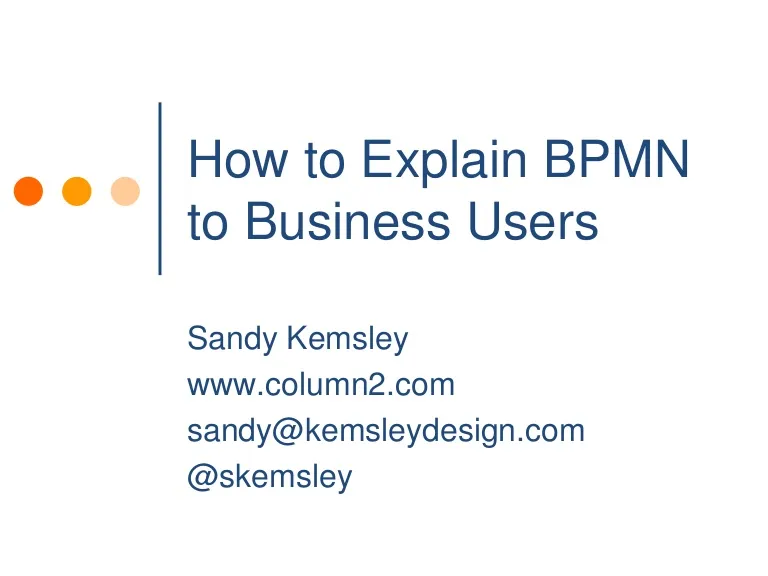How To Explain BPMN To Business Users
Description
Slides from a webinar that I presented on June 9, 2010, as part of the Active Endpoints BPM Summer Camp series.
Transcript
How to Explain BPMN to Business Users
Sandy Kemsley
www.column2.com
sandy@kemsleydesign.com
@skemsley
DON’T PANIC
Replay and slides will be available
Agenda
What’s all this BPMN stuff anyway?
How much do we really need to know?
What advanced bits might come in handy?
Recap from February: BPMN Is Simple...
Activity
Gateway
Event
Data
Source: http://bpmb.de/poster
The BPMN 2.0 Problem
More than 100 elements
Unlikely to be fully understood by most experts, much less users
Unlikely to be fully supported by most vendors
Has led to rejection of BPMN in favor of “simpler” modeling paradigms
The BPMN 2.0 Solution
Not everyone needs to learn everything
Group BPMN elements into sets used by different personas
Business user
Business analyst
Architect/developer
Each level adds more detail to model
COMPLETE
Plus 50 elements
DODAF
Plus 29 elements
DESCRIPTIVE
Pool
Lane
messageFlow
userTask
serviceTask
Re-Usable subProcess
dataObject
dataInput
dataOutput
textAnnotation
Association
dataAssociation
dataStore
messageStartEvent
messageEndEvent
timerStartEvent
terminateEndEvent
SIMPLE
sequenceFlow
Task (none)
subProcess(embed)
exclusiveGateway
parallelGateway
startEvent (none)
endEvent (none)
BPMN 2.0 Subclasses:Early Version
Source: Workflow Management Coalition’s “Update on BPMN Release 2.0”
BPMN 2.0 Subclasses: Recent Version
Descriptive
Visible elements for high-level models
Used by business analysts
Analytic
All of Descriptive plus elements for DoDAF enterprise architecture models
Commonexecutable
All of analytic plus elements for executable models
Descriptive Subclass
participant (pool)
laneSet
sequenceFlow (unconditional)
messageFlow
exclusiveGateway
parallelGateway
task (None)
userTask
serviceTask
subProcess (expanded)
subProcess (collapsed)
callActivity
dataObject
textAnnotation
association/dataAssociation
dataStoreReference
startEvent (None)
endEvent (None)
messageStartEvent
messageEndEvent
timerStartEvent
terminateEndEvent
documentation
group
Source: Workflow Management Coalition’s “Update on BPMN Release 2.0”
Pool
Message
Flow
Data
Object
Sub Process
(Collapsed)
User
Task
Lane
Message Start Event
Message End Event
Data
Association
Call Activity
(Collapsed)
Service
Task
Text
Annotation
Association
Descriptive Subclass Example
Data
Store
Source: Workflow Management Coalition’s “Update on BPMN Release 2.0”
Descriptive Subclass Example
Analytic Subclass
sequenceFlow (conditional)
sequenceFlow (default)
sendTask
receiveTask
Looping Activity
MultiInstance Activity
exclusiveGateway
inclusiveGateway
eventBasedGateway
signalStartEvent
signalEndEvent
errorEndEvent
message
Plus: Intermediate events
Analytic Subclass: Intermediate Events
Catching message
Throwing message
Boundary message
Non-interrupting Boundary message
Catching timer
Boundary timer
Non-interrupting Boundary timer
Boundary error
Non-interrupting Boundary escalation
Throwing escalation
escalationEndEvent
Catching signal
Throwing signal
Boundary signal
Non-interrupting Boundary signal
condtionalStartEvent
Catching conditional
Boundary conditional
Non-interrupting Boundary conditional
The Analyst’s Dilemma
Descriptive is a manageable subset
Analytic is too much, except for serious process experts
Some of the event concepts in analytic subset are required for analysis and modeling
Oh Yeah...
...we left the business users out
What Do Business Users Really Need?
Smaller subset of elements (?)
Depends on user skills/aptitude
Comprehension of BPMN without necessarily being able to model:
Work with analysts to capture processes
Review and approve models, with a cheat sheet or generous annotation
And back to Alex…
Sandy Kemsley
www.column2.com
sandy@kemsleydesign.com
@skemsley
